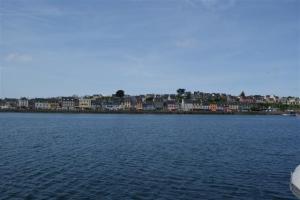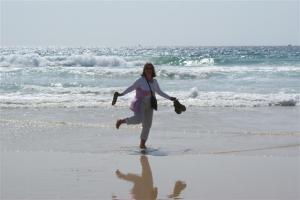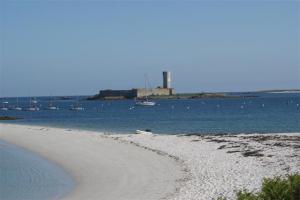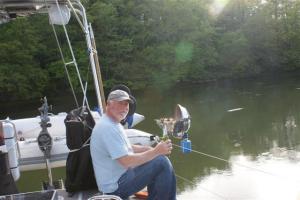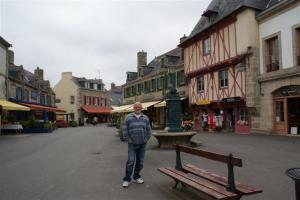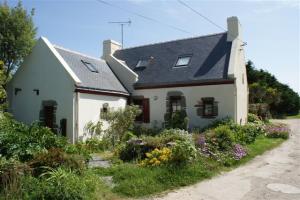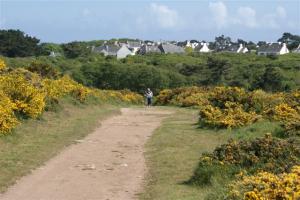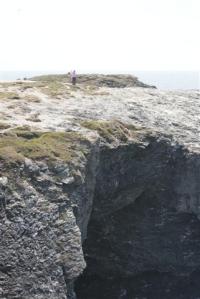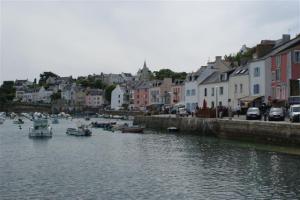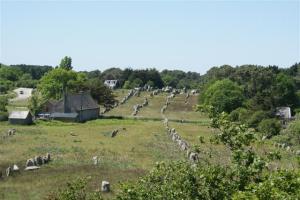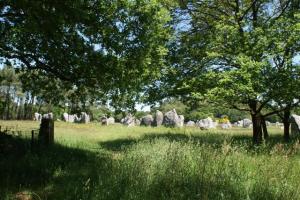Monthly Archives: May 2009
The Cote de Cornouaille and the Cote de Megaliths, visiting the southern Breton islands on the way.
We sat in L’AberWrach for 2 days while the wind abated. On the third day we motored out with the wind on the nose but the swell had gone right down. We turned south into Chenal du Four as this was as far west as we could go. The choppy channel had finally released us without a struggle, we were happy to leave it behind. The wind started to drop and we watched a front pass over us with blue sky behind it.
We motored into Cameret mid afternoon and found a space in the inner marina right next to the town.
On the Friday we went for a bike ride to my favourite beach at the end of the Toulinquet peninsular; it was just warm enough to paddle in the sea.
The Saturday was my birthday and we spent the day eating. Petit déjeuner in a bar on the water front, crêpes for lunch, and a beautiful dinner in the evening with langoustines (large prawns), several types of fish and a peach melba for dessert plus wine. I was really spoilt. We had a lazy day on Sunday watching the French leave after the weekend; always a source of entertainment.
We left Cameret on the Monday. We motored towards the Toulinguet point, hoisted the sails, turned off the engine and we were away. We always go around the point but having watched other keel boats go through the passage when we were on the beach we decided to go through the rocks.
It was a bit nerve-racking but we passed through unscathed, we also had an excellent view of the caves and the beach. Within an hour we were at the Raz de Sein another notorious sailing black spot but the wind and tide was with us and we sailed though without a problem on towards the Pointe de Penmarc’h – Gateway to Southern Brittany and the Sun. We were now entering the Biscay and it was sunny, hopefully it will stay that way. We continued eastwards into Benodet bay to the first port of Loctudy and tied up to the visitor’s pontoon.
The next day we walked into the town to visit the market and I bought some freshly caught king prawns for our lunch, some strawberries and a slice of raspberry Breton cake which is similar to bakewell tart, it’s not so almondy but delicious.
The following day we found ourselves in Iles de Glenan, a beautiful archipelago with white sandy beaches not unlike the Caribbean. I sat in the cockpit looking across the shimmering sea to the white sandy beach where yesterday we had walked bare foot collecting the most beautiful shells and all I could hear was the gentle lapping of the water against the side of the boat and the call of the seagulls. We’d spent the night on a buoy, it was an idyllic spot; and we virtually had it to ourselves. This is what I had been looking forward to.
We left the Glenans that afternoon because the winds were getting stronger and as the islands are little more than sand dunes they don’t offer any protection. We set sail north to Bénodet which only took a couple of hours. Bénodet occupies the east bank of the Odet River, which is one of the loveliest rivers in Southern Brittany.
We waited until the tide was at half flood and left to start our journey up the river passing several beautiful chateaux with their manicured gardens stretching down to the waters edge. It was a beautiful day and the sun was shining on the steep tree-covered banks giving all the leaves a wonderful luminous glow, this in turn reflected in the water as a dark shade of green but the water was so clear. We knew we couldn’t go right to the top because it dries out and there isn’t anywhere to tie alongside but we had found a little anchorage called Anse de St-Cadou. We crept in at high tide. We had 4.2 metres under our keel and it was a 4 metre tide so it should be ok. Down went the anchor. The fall of the tide revealed some rocks around the bank but nothing in our way.
It was a lovely evening and we decided to try our new barbecue. We had a splendid feast in wonderful isolation. As it got dark the noises of the forest that surrounded us were quietly noisy. At low tide we were sitting in a pool with 0.3 metres under our keel. We swung round with the tide and you could just hear a slight scraping as the rudder lightly dragged over the shingle bottom. Happy that we were safe we retired to bed. The next morning was wonderful. I got up early and sat out on deck, all that could be heard were the birds twittering in the trees. I watched a Heron picking his way along the waters edge looking for tasty morsels and a Cormorant sitting on a rock drying his wings in the sun. What a lovely spot.
We decided to take the dinghy to Quimper, another 5 miles up the river. Unofficially the capital of Cornouaille Quimper is dominated by the twin spires of its Gothic Cathedral which tower over the banks of the river. When they added the Nave in the 15th century, to avoid the swampy edge of the river, the masons of the time placed it on an angle; it’s very strange walking down the aisle. Once out in the sunshine we walked around the old quarter, its cobbled streets lined with charming half-timbered houses above shops selling antiques, lace and local craftwork. At the heart of the city flower-decked footbrides criss-cross the river. We stopped for a crêpe before we returned to the dinghy for the trip back down the river to the boat. We spent another night at anchor because it was such a lovely place.
We left the anchorage at 10.00 on the high tide creeping back out into the Odet and motored back down the river to St Marine which is on the West bank of the river.
We left St Marine mid morning and tied up in Concarneau at 15.30. The attraction at Concarneau is the Ville Close and we went to have a look around the next day.
The Ville Close is a walled town dating back to medieval times. You enter over a drawbridge between two Granite ramparts that lead into a busy thoroughfare lined with shops and restaurants. Narrow cobbled streets and alleys branch off in all directions between little courtyards and squares bedecked with flowers in window boxes and tubs. It was absolutely charming.
We motored out of Concarneau the next day and set sail for the Belon river. Shortly after turning the engine off Bill decided to try his luck at fishing, he put the lines out and within half an hour had caught one.
Bill reeled it in and put it in a bucket. He then decided to dip the bucket in the water to fill it and, surprise surprise, the fish came to life and leapt for freedom! The 2nd one got away and after that he caught 4 more but they were too small and he put them back but we do have photographic evidence of the one that got away!
We motored into the Belon river just after 19.00 on the high tide. The river has a sand bar over the entrance that can only be passed at high tide when it’s then covered by the sea.
We tied up fore and aft to large metal buoys. The next day we took the dinghy ashore to explore. Belon is famous for its oysters and the sides of the river were covered in oyster beds, which were exposed at low tide. We went for a lovely walk along the coastal path that gave us beautiful views of the river with glimpses of Camomile through the trees.
The next day we decided to visit Pont Aven.
It was at the head of the next river and we decided to cycle there. It wasn’t far, only 5 miles or so but it was a bit hilly. Pont Aven was the home of Paul Gauguin and if he returned today he would still recognise many of its old houses and watermills even though the mills are no longer working. The river tumbles steeply down between great outcrops of granite that served as the driving force of the mills. These days there are enchanting walkways built across the river so that many of these wonderful old buildings can be viewed. It was a beautiful setting.
Many of the bridges carry holders for flower boxes and in the summer it will look very pretty. It was already starting to look colourful. We cycled back to Belon and packed the bikes back into their bags and set off in the dinghy for the boat. We had quite a bumpy crossing, the wind had got up while we were away and the river was quite choppy. We raised the dinghy on the davits ready to leave the next morning.
We didn’t leave the next morning or the morning after that. The wind was relentless. It didn’t go below F7 for 2 days. We couldn’t even get off the boat because it was too choppy to launch the dinghy. The storm was blowing right across the Biscay from the southwest. The entrance to the river faces SW and the charts give warnings of crossing the bar in a SW gale. The French are officially barking because they were still going in and out. We spent our time doing little jobs. I suggested to Bill he could go up the mast to mend the wind instrument; he said he would hold the screwdriver while I put the harness on!!!
Monday morning we finally managed to get out of the Belon river, we had only been there 5 days but it felt longer. The wind was still blowing from the southwest, but it had dropped enough for us to escape. High tide was at 12.30. We untied the many lines we had tying us to the buoy and left at 11.15. The swell was still coming in over the bar but we managed to get out safely.
As we were travelling southeast to Ile de Groix we had a wonderful beam reach all the way. We arrived at Port Tudy harbour at 14.15; it had taken exactly 3 hours. The town of Port Tudy was very pretty, in an untidy island sort of way. The houses were painted many colours, although some of them didn’t match very well but the gardens were becoming very colourful as we get further into the summer.
The following day we spent cycling around the island, it’s only 5 miles long and 2 miles wide with a marked cycle path all the way around. We managed to cycle most of it between acres of yellow gorse. It made it seem very desolate at times but still beautiful.
We left Port Tudy the next morning bound for Belle Ile, another island, our 6th so far. It was a beautiful sunny day with a light southeasterly wind. We arrived at Le Palais at 18.00. The next day the bikes came out again for another cycle ride.
Belle Ile also has marked cycle paths but, being a bigger island at 10 miles long and 5 miles wide, we only cycled half the island. Belle Ile means beautiful island and it certainly was. We headed south to the other side of the island that faces the Atlantic. It was very rugged and rocky but had some beautiful beaches in between.
We stopped at one of them for lunch and watched the French surfing on the Atlantic rollers. We continued north along the spectacular coastline to the Grotte de l’Apothicairerie. This is an oceanfront cave so called because it used to be filled with the nests of cormorants, arranged like the jars on a pharmacist’s shelves. It’s viewed from above and we teetered as near to the edge as we dare to see inside but it was a long way down to the rock-strewn sea.
We continued across the island to the harbour of Sauzon. It was absolutely charming with some beautifully painted houses with roses around their doors, a real picture postcard village.
We stopped for an ice cream but then returned to Le Palais. Fortunately it was down hill all the way. We spent the following day walking around the town. The citadel, a star shaped fort built by Vauban in the 18th century, dominates the town. We wandered around the ramparts, which look down onto the beautiful blue sea below.
We arrived late at the Tréac’h er Gourhead beach off the island of Houat (pronounced to rhyme with that) on 25th May; the anchor dug in well and we sat down to a late supper. The forecast said F5/6 from the west and as the anchorage is on the East coast we felt comfortable with that. I don’t know why we bother with forecasts because we went to bed with it gusting F7 and Bill was up at 3am letting more chain out because it was F8 gusting 9. Fortunately the new anchor and 10ml chain held us firm.
We awoke the next morning to find it had dropped so we walked across the island. Flowers from the gardens spread across several houses; there were roses and yellow broom growing everywhere. There is a harbour on the other side of the island but it’s full of fishing boats as their industry is mostly fishing, and lobsters in particular.
We walked for several miles around the island returning to the dinghy via the narrow headland to the north, picking our way through the rick pools, the views were stunning. It was so peaceful we decided to stay a 3rd night.
On the Thursday morning we left the anchorage and motored back across the Quiberon bay. It’s starting to get quite hot and for the first time this year we were able to take our clothes off and enjoy the sun. We arrived in La Trinite in t-shirts and moored up just after lunch. We had now left the Cote de Counouaille and joined the Cote des Megalithes.
No one knows who erected the Megaliths, it was long before the start of recorded history, or why. The most popular theory is astronomical but they date from the time of the arrival of agriculture. Could they have been linked to an annual harvest, they were certainly erected over a period of time; they are stark reminders of how little we know of our own origin.
La Trinite’s neighbour is Carnac. It’s profusion of Menhirs laid out in groups of a thousand or more, undulating across the countryside in long irregular rows, make an extraordinary spectacle. It’s no longer possible to enter the sites but the fences are fairly low and they can be viewed easily; I find them fascinating.
